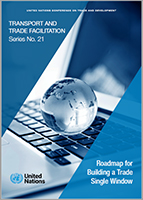
The implementation of a national electronic Single Window for international trade is considered one of the most effective measures to enhance trade facilitation in a country – a view recognised by its inclusion as an obligation under the WTO Trade Facilitation Agreement.
A core element of any national electronic Single Window for international trade is an automated customs system. Any country operating a standards-based automated custom system, such as ASYCUDA, enabling the submission of electronic customs declarations, is well placed to start the process of developing an electronic Single Window for trade.
The purpose of this roadmap is to help countries that already use ASYCUDA software, or other standards-based automated custom systems, to design, build and implement a tailor made electronic Single Window system based on existing capacities. This approach helps countries to leverage their existing investment, and reduce both the time and cost of establishing an electronic Single Window.
Structure of the roadmap
Chapter 2 provides an overview and background on the evolution of the electronic Single Window concept, the key international recommendations underpinning it, and the overall rational for using one.
Chapter 3 describes the core principles for successfully implementing an electronic Single Window, based on over 20 years of usage around the world.
Chapter 4 details the experience of the ASYCUDA Programme in electronic Single Window implementation and provides details of both the technical and managerial approaches used.
Chapter 5 provides an overview of the first eleven Single Window implementations facilitated by the ASYCUDA Programme.
Chapter 6 provides concluding comments.
In addition, annex I – III details three ASYSW (UNCTAD Automated System for Single Window) implementations – specifically Jamaica, Rwanda and Timor-Leste.
These case studies provide deeper insight into how each of the above countries approached eSW implementation by leveraging their existing ASYCUDA system. They detail how the ASYSW implementation principles and steps were undertaken; how the project was set up and managed; what technical approach was adopted in each case; and the key successes, challenges and lessons learned.
It is hoped that these case stories will provide practical guidance to electronic Single Window project implementors in other countries. Annex IV details how countries may approach ASYCUDA for technical assistance.




